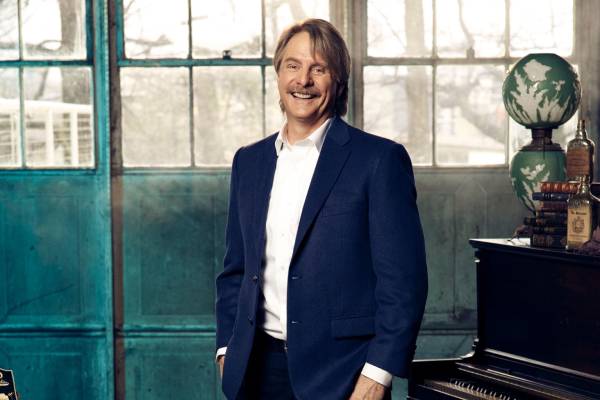There has been much talk about reinvention over the last few months as the challenges posed by the COVID-19 pandemic have upended the television production industry and caused broadcasters to overhaul schedules. But in the unscripted business, reinvention has been a programming prerequisite for some time, as producers and their network partners are constantly in search of the format that can offer a fresh twist on the familiar.
In the spring, A&E announced the greenlight of a new series in the “artefactual” genre pioneered by the network and its sister network History following the 2008 financial crisis. From the network group that brought us Pawn Stars and American Pickers, a new series, What’s It Worth… Live, was unveiled, to be produced by ITV America prodco Thinkfactory Media and hosted by American comedian Jeff Foxworthy (pictured). The series would see participants with potential hidden treasures in their attics and elsewhere bring them to the studio, where both experts and the folks at home could weigh in, in real time, on what the items could be worth.
“In looking at the collectibles space, we realized no one had really upended or revamped that arena anytime in recent memory,” says Thinkfactory CEO Adam Reed, in advance of the premiere of a summer iteration of the series, airing tonight (August 4). “We felt it was ripe for an overhaul and saw an opportunity to create a louder, splashier series that offered more.
“It started with, ‘Can we create a series where people showcase interesting items from their homes?’” he adds. “And in taking things a step further, that conversation turned into, ‘What if we gave folks across America the opportunity to bid on those items?’ Building from the interactive element, we incorporated the ‘live’ piece, and we were off to the races.”
While the prodco pitched it wide, Reed says A&E, home to Storage Wars, “immediately sparked to the idea” and taking it to the network seemed like a “perfect marriage.”
Says A&E’s EVP of programming, Elaine Frontain Bryant, “We were excited about that live element because it felt like a re-invention of the existing shows in the genre but with a new, exciting live twist, which viewers hadn’t seen before.”
But then along came the pandemic.
While the live version of the series was originally slated to debut this summer, Frontain Bryant says, “it became clear that bringing people in from all over the country wasn’t practical.” To keep the idea afloat, a COVID-proof revamp was in order.
“We went through extraordinary lengths to ensure the version we developed – What’s it Worth? – didn’t feel like ‘COVID programming,’” says Reed. “It was important to us that what people see when they tune in to A&E on Tuesday nights stands on its own as a great series – COVID or no COVID. This isn’t something that was thrown together as a temporary solution; it was carefully thought out and executed by our team and our counterparts at the network.”
“With people suddenly spending more time in their homes and looking for projects, they’ve started taking a closer look at what items they own which has led them to wondering what hidden treasures they might be coming across buried in their attics and basements,” says Frontain Bryant. “From that revelation, we realized that a new remote version of the show could work and viewers might relate to this new virtual format.
“Also, in the summer — especially this summer — people are really looking for feel good options to watch,” she adds. “From a pure entertainment perspective, we feel our audience really craves seeing positive outcomes for people during these times we are living in.”
Once the decision was made to revamp the format for remote production, the hard work of putting it together began.
“Jeff was filmed in the basement of his house, while we operated remote cameras from a control room in Washington D.C.,” explains Reed. “The show’s experts all joined from their own homes via video conferencing links, and the item owners and their families all self shot with various devices.
“Our remote team in D.C. is managing all feeds, while also coordinating communications between Jeff, the production team, our experts and the item owners – ensuring all goes smoothly,” he elaborates. “I’m operating out of my home office in LA, as our entire producing team does the same from their homes, overseeing the various feeds from across the country, while on video conference with my production team on one monitor and with the network’s team on another monitor. Meanwhile, Jeff has the whole team in his ear and one crew member in his basement with him at any given time.”
Says Frontain Bryant: “Connectivity was definitely an early issue just in terms of making sure everyone was able to see and hear each other while shooting. But in a weird way that also speaks to the times we are living in because we are all facing that same challenge day-to-day so it adds to the authenticity of this show.”
Both Frontain Bryant and Reed point to some unexpected, surprising moments that arise under such conditions that probably wouldn’t have happened under a normal shoot.
“There were wives trying to film their husbands, and vice versa; we had a kid walk in in his underwear while his parents were on camera,” Reed says. “We didn’t shy away from those unplanned moments; it all just added to the fun.”
As Thinkfactory looks forward to the response to the 10-episode summer series, the company — now fully owned by ITV America — is looking to hone in on further format development and broaden its formats catalog.
“It’s not enough to have a good concept, you also need to bring elements to the table that put that good concept through a funhouse mirror, creating something that feels bigger and more intriguing than anything that’s come before it,” says Reed, adding that the company has recently sold original formats to History and OWN, and has adapted and sold an international format to TBS.
As prodcos and networks kick production back into gear, they both face uncertain financial challenges wrought by the pandemic but also, conversely, newfound opportunity as unscripted content emerges as a schedule savior of sorts, in the absence of scripted series hobbled by production lags. While Reed asserts that “co-viewing is the holy grail right now,” Frontain Bryant draws parallels between the time that birthed the original wave of transactional TV, and today’s cultural climate.
“History’s Pawn Stars and American Pickers, as well as our own Storage Wars, were born from the 2008 recession,” she says. “Leaning into and finding the value of what you already have, with a little entrepreneurial grit, is likely to come about again and I cannot wait to see all the ways people reinvent themselves after this crisis.”
(Photo: Justin Stephens)
View the full article here.

